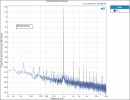This is a review and detailed measurements of the Mofi Studiophono MM/MC phono preamplifier. It is on kind loan from a member and costs US $349.

The packaging has a retro feel to it and I don't mean that as a positive. When a device has the word "studio" in it, I expect solid metal enclosure, not plastic. There is selectable subsonic filtering but oddly, you have to press the button in to defeat it! There is also a mono switch which I understand to be very useful for playing vintage mono LPs.
The thing I really dislike about the StudioPhono is the seemingly endless number of DIP switches underneath:

Not only the plurality is a problem, but so is the stiff switches. I was worried I was going to break the tiny tabs in trying to move them. Worse yet, you can't really tell their positions as they don't slide all the way to each end. Not wanting to damage the switches, I left the unit with all switches off which means a gain of "40 dB" and cartridge loading of 47K Ohm.
Mofi StudioPhono Measurements
I had to mess a fair bit to get the least amount of mains noise for our dashboard (5 mv input):

I see no distortion spikes which is good. SINAD therefore is dominated by power supply noise and lands the unit slightly below average:

Most important test for a phono stage is the accuracy of RIAA equalization so let's measure the frequency response:

Well, this is not very good. We have a rise in gain with frequency so likely the unit will add a bit of brightness. Good news is the sharp subsonic filter so gets rid of most rumble without messing with musical content at low frequencies.
There is decent amount of headroom but short of what I like to see:

It does however stay frequency independent which is very good:

Finally, level of distortion is respectably low:

Conclusions
You already know my feeling about the packaging so I won't belabor that point. Technically, performance is about average with RIAA equalization being a bit worse than average. A bit more focus on accuracy would have lifted the unit up a notch in my opinion.
As it is, I can't recommend the Mofi PhonoStudio.
-----------
As always, questions, comments, recommendations, etc. are welcome.
Any donations are much appreciated using: https://www.audiosciencereview.com/forum/index.php?threads/how-to-support-audio-science-review.8150/
The packaging has a retro feel to it and I don't mean that as a positive. When a device has the word "studio" in it, I expect solid metal enclosure, not plastic. There is selectable subsonic filtering but oddly, you have to press the button in to defeat it! There is also a mono switch which I understand to be very useful for playing vintage mono LPs.
The thing I really dislike about the StudioPhono is the seemingly endless number of DIP switches underneath:
Not only the plurality is a problem, but so is the stiff switches. I was worried I was going to break the tiny tabs in trying to move them. Worse yet, you can't really tell their positions as they don't slide all the way to each end. Not wanting to damage the switches, I left the unit with all switches off which means a gain of "40 dB" and cartridge loading of 47K Ohm.
Mofi StudioPhono Measurements
I had to mess a fair bit to get the least amount of mains noise for our dashboard (5 mv input):
I see no distortion spikes which is good. SINAD therefore is dominated by power supply noise and lands the unit slightly below average:
Most important test for a phono stage is the accuracy of RIAA equalization so let's measure the frequency response:
Well, this is not very good. We have a rise in gain with frequency so likely the unit will add a bit of brightness. Good news is the sharp subsonic filter so gets rid of most rumble without messing with musical content at low frequencies.
There is decent amount of headroom but short of what I like to see:
It does however stay frequency independent which is very good:
Finally, level of distortion is respectably low:
Conclusions
You already know my feeling about the packaging so I won't belabor that point. Technically, performance is about average with RIAA equalization being a bit worse than average. A bit more focus on accuracy would have lifted the unit up a notch in my opinion.
As it is, I can't recommend the Mofi PhonoStudio.
-----------
As always, questions, comments, recommendations, etc. are welcome.
Any donations are much appreciated using: https://www.audiosciencereview.com/forum/index.php?threads/how-to-support-audio-science-review.8150/
Last edited:


